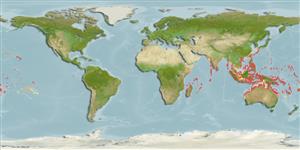Common names from other countries
>
Eupercaria/misc (Various families in series Eupercaria) >
Caesionidae (Fusiliers) > Caesioninae
Etymology: Pterocaesio: Greek, pteron = wing, fin + Latin, caesius = blue grey (Ref. 45335).
More on author: Schultz.
Environment: milieu / climate zone / depth range / distribution range
Ecologie
marien rifbewoner; standvastig; diepte 1 - 30 m (Ref. 58018), usually ? - 10 m (Ref. 89972). Tropical; 34°N - 31°S, 39°E - 133°W (Ref. 402)
Indo-Pacific: East Africa, not including the Red Sea or the Arabian (Persian) Gulf, to the Marquesas Islands.
Grootte / Gewicht / Leeftijd
Maturity: Lm ? range ? - ? cm
Max length : 35.0 cm TL mannelijk / geslacht onbekend; (Ref. 402)
Dorsale stekels (totaal) : 10 - 11; Dorsale zachte stralen (totaal) : 14 - 16; Anale stekels: 3; Anale zachte stralen: 11 - 13. Upper body blue to greenish, lower whitish. 4-6 cheek scales; 24-32 predorsal rays; scaled dorsal and anal fins. Upper peduncular scale rows usually 12 or 13 (12-14); lower peduncular scale rows usually 16 or 17 (15-17). Post maxillary processes 2; posterior end of maxilla tapered. The process on ventrolateral surface of basioccipital for attachment of Baudelot's ligament not extending beyond a horizontal with condyle's rim (Ref. 1723). Caudal fin lobes with dark tips. Head length 3.0-3.7 in SL; body depth 3.4-4.6 in SL (Ref. 90102).
Ranges widely around coral reefs (Ref. 58652) and appears to prefer clear waters of oceanic islands or reefs far from large land masses. Feeds on zooplankton in midwater aggregations. Oviparous, with numerous, small pelagic eggs (Ref. 402). Also caught by drive-in nets. Used as tuna baitfish.
Levenscyclus en paargedrag
Maturities | Voortplanting | Spawnings | Egg(s) | Fecundities | Larven
Carpenter, K.E., 1987. Revision of the Indo-Pacific fish family Caesionidae (Lutjanoidea), with descriptions of five new species. Indo-Pac. Fish. (15):56 p. (Ref. 1723)
Status op de Rode Lijst van het IUCN (Ref. 130435)
CITES (Ref. 128078)
Not Evaluated
Gevaar voor de mens
Harmless
Gebruik door de mens
Visserij: van minder commercieel belang; aas: occasionally
Tools
Speciale rapporten
Download XML
Internetbronnen
Estimates based on models
Preferred temperature (Ref.
115969): 25.2 - 29.3, mean 28.5 (based on 3174 cells).
Fylogenetische diversiteitsindex (Ref.
82804): PD
50 = 0.5002 [Uniqueness, from 0.5 = low to 2.0 = high].
Bayesian length-weight: a=0.01072 (0.00467 - 0.02458), b=3.12 (2.94 - 3.30), in cm Total Length, based on LWR estimates for this Genus-body shape (Ref.
93245).
Trofisch niveau (Ref.
69278): 3.4 ±0.45 se; based on food items.
Weerstandsvermogen (Ref.
120179): Hoog, minimale populatieverdubbelingstijd minder dan 15 maanden (Preliminary K or Fecundity.).
Fishing Vulnerability (Ref.
59153): Low vulnerability (25 of 100).
